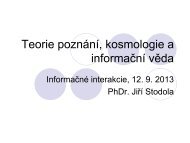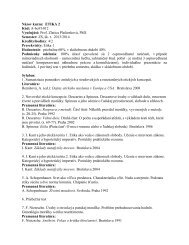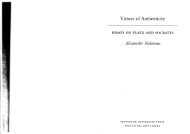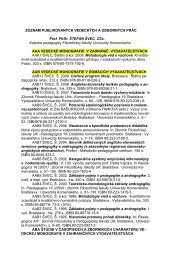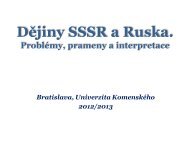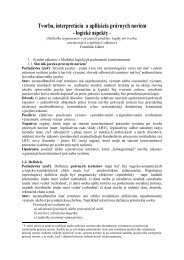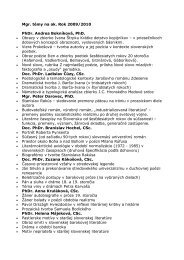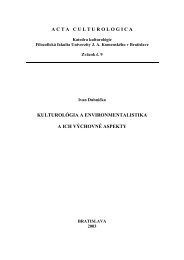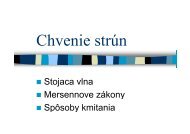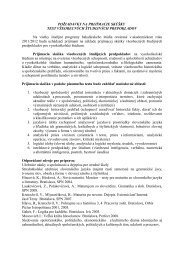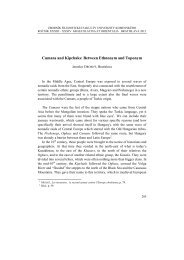Department of British and American Studies at the - Univerzita ...
Department of British and American Studies at the - Univerzita ...
Department of British and American Studies at the - Univerzita ...
Create successful ePaper yourself
Turn your PDF publications into a flip-book with our unique Google optimized e-Paper software.
In this passage, Hester Prynne undergoes a transform<strong>at</strong>ion nearly worthy a conjuror‘s effort.<br />
She becomes a different person entirely, as if her previous, indistinct <strong>and</strong> dulled identity were<br />
a tabula rasa on which her new self could find fertile ground to sprout. The very physical <strong>and</strong><br />
n<strong>at</strong>uralistic description <strong>of</strong> Hester‘s temporary liber<strong>at</strong>ion, <strong>the</strong> glow th<strong>at</strong> replaces <strong>the</strong> paleness,<br />
<strong>and</strong> her new inner glitter – all th<strong>at</strong> serves as a memento th<strong>at</strong> <strong>the</strong> power <strong>of</strong> symbols which are<br />
considered so important by Hester‘s judges <strong>and</strong> fellow Puritans relies on <strong>the</strong> human capacity<br />
to perceive <strong>and</strong> interpret <strong>the</strong>m. The symbols <strong>the</strong>mselves are meaningless, but combined with<br />
<strong>the</strong>ocr<strong>at</strong>ic tendencies, <strong>the</strong>y bring along de-personalizing <strong>and</strong> de-humanizing susceptibilities.<br />
Thus, minister Hooper terrifies his parishioners, becoming ―a monster for <strong>the</strong> symbol bene<strong>at</strong>h<br />
which [he has] lived <strong>and</strong> [will] die‖ (Hawthorne 1987: 157). Hooper‘s last words vibr<strong>at</strong>e with<br />
Hawthorne‘s significant message, namely th<strong>at</strong> in symbolizing his own inability to deal with<br />
sin, grief or utter depression, Hooper represents all people: ―I look around me, <strong>and</strong>, lo! on<br />
every visage a Black Veil!‖ (157).<br />
Hawthorne <strong>at</strong>taches gre<strong>at</strong> value to <strong>the</strong> innermost self <strong>of</strong> his characters <strong>and</strong> places <strong>the</strong>m<br />
in situ<strong>at</strong>ions in which <strong>the</strong>y ei<strong>the</strong>r emerge from underne<strong>at</strong>h <strong>the</strong>ir symbolic surface (Hester), or<br />
stay covered <strong>and</strong> hidden forever (Hooper), or – ironically enough – manage to do both<br />
(Goodman Brown). The inner personality – <strong>the</strong> human heart – is for Hawthorne a source <strong>of</strong><br />
one‘s true identity <strong>and</strong> <strong>the</strong>refore <strong>the</strong> most important <strong>and</strong> primary element necessary for<br />
improvement, like, for example, in <strong>the</strong> story Earth‟s Holocaust:<br />
The heart, <strong>the</strong> heart […] Purify th<strong>at</strong> inward sphere, <strong>and</strong> <strong>the</strong> many shapes <strong>of</strong> evil th<strong>at</strong><br />
haunt <strong>the</strong> outward, <strong>and</strong> which now seem almost our only realities, will turn to<br />
shadowy phantoms <strong>and</strong> vanish <strong>of</strong> <strong>the</strong>ir own accord; but if we go no deeper than <strong>the</strong><br />
intellect, <strong>and</strong> strive, with merely th<strong>at</strong> feeble instrument, to discern <strong>and</strong> rectify wh<strong>at</strong> is<br />
wrong, our whole accomplishment will be but a dream. (247)<br />
There is both sunshine <strong>and</strong> gloom in Hawthorne‘s texts – just like Herman Melville wrote<br />
about his fellow writer <strong>and</strong> friend in <strong>the</strong> essay Hawthorne <strong>and</strong> His Mosses: ―For spite <strong>of</strong> all<br />
<strong>the</strong> Indian-summer sunlight on <strong>the</strong> hi<strong>the</strong>r side <strong>of</strong> Hawthorne‘s soul, <strong>the</strong> o<strong>the</strong>r side – like <strong>the</strong><br />
dark half <strong>of</strong> <strong>the</strong> physical sphere – is shrouded in a blackness, ten times black‖ (Melville,<br />
Parker, <strong>and</strong> Tanselle 1987: 243). It is this darkness, unf<strong>at</strong>homable <strong>and</strong> seemingly unjustified,<br />
which acts both as an aspect <strong>of</strong> Hawthorne‘s art <strong>and</strong> identity as a writer descended from<br />
Puritan forebears, whose social predicament came to constitute an important part <strong>of</strong><br />
America‘s past. Though conformist <strong>and</strong> controversial from a modern point <strong>of</strong> view, <strong>the</strong><br />
Slovak <strong>Studies</strong> in English, Vol. 3, 2011 – Identity in Intercultural Communic<strong>at</strong>ion<br />
180



